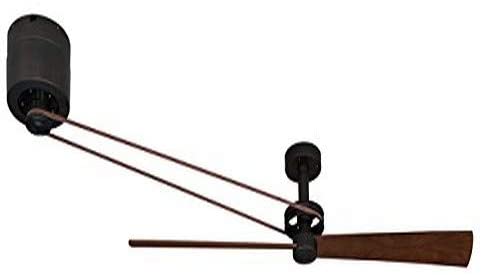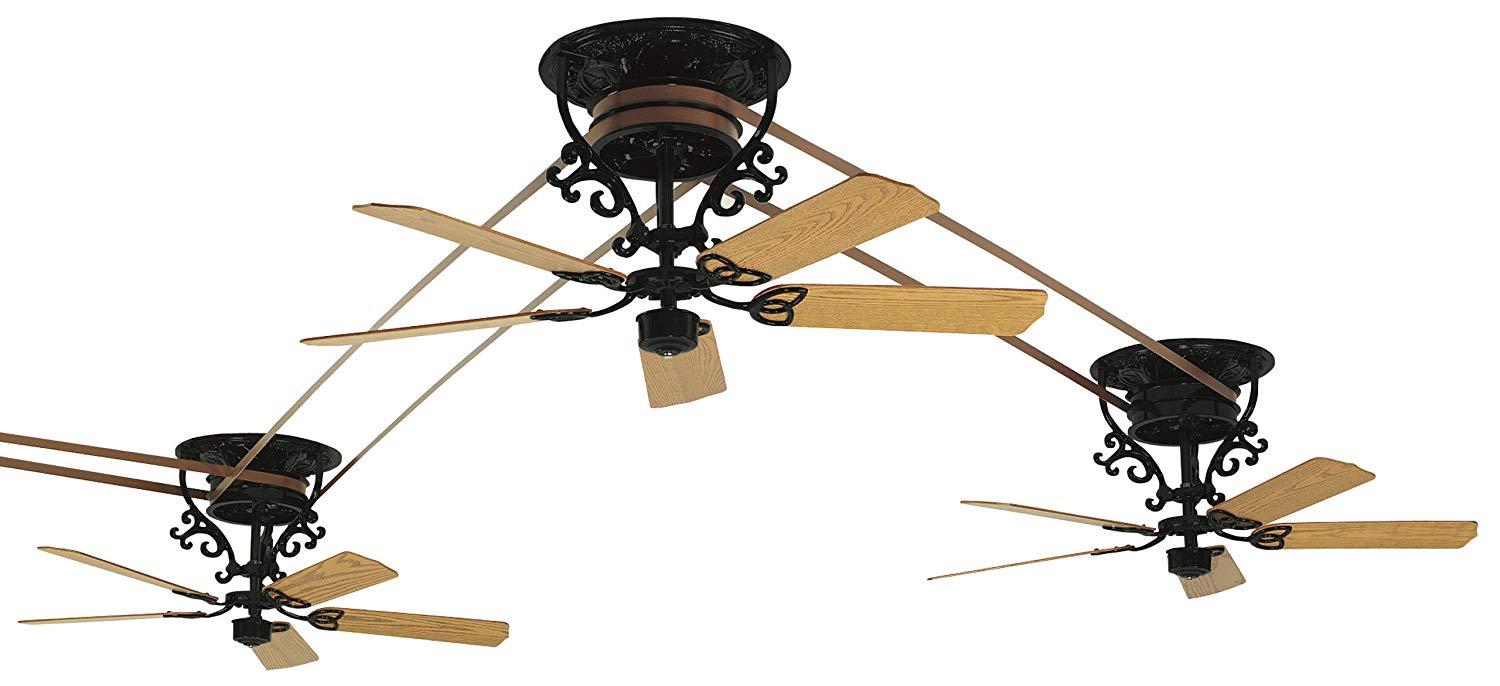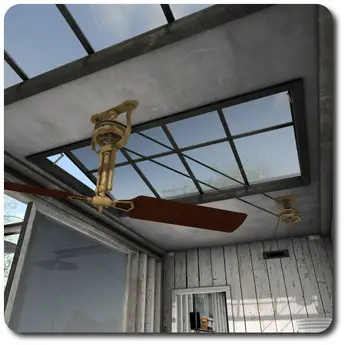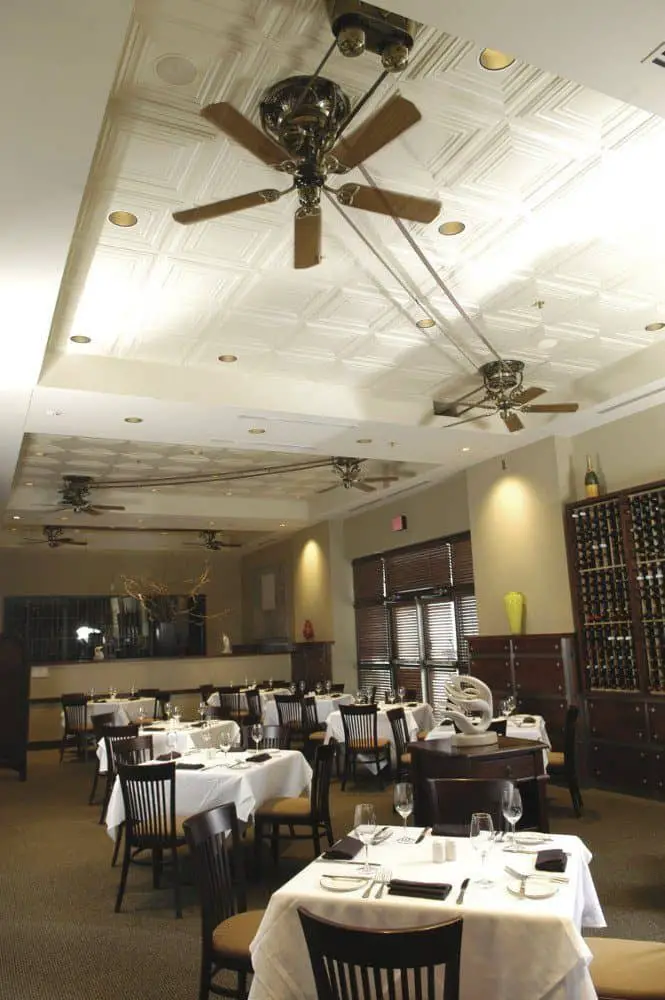The belt-fan concept has been around for more than a hundred years. It efficiently combats cold and hot temperatures while giving your home’s interior a steampunk, western look.
This article will take you through the best belt-driven ceiling fans and how to choose them.
Comparison of the Best Belt Driven Ceiling Fans
| IMAGE | PRODUCT | |
|---|---|---|
Our Top Pick  |
| View Latest Price → |
 |
| View Latest Price → |
Best Budget Option  |
| View Latest Price → |
 |
| View Latest Price → |
How to Choose a Belt-Driven Ceiling Fan
You need to consider several factors before buying any of the best belt-driven ceiling fans. We’ll take you through a few of the most significant elements.
Blade Span
The blade length has a substantial impact on how much airflow the unit can generate. In most cases, longer sections can deliver better airflow. You’ll need to measure your room’s area where you want to install the ceiling fan to help you decide which will suit you best.
Number of Blades
Similarly, more blades can improve airflow. However, it will cause more strain on the system and result in higher energy consumption. Two to three blades are sufficient for small areas, while three to four provide an excellent balance between efficiency and effectiveness in larger rooms.
Airflow
Some manufacturers place a label on the packaging to indicate how much airflow the belt-driven ceiling fans can generate in the right conditions. Categorized as cubic feet per minute (CFM), companies determine efficiency by dividing the CFM by watts used (CFM/W).
You’ll also need to consider the room size to ensure that the CFM value is sufficient.
Design
You don’t want a ceiling fan system with colors and panels that clash with your room’s interior design. If you’re shopping for these units, ensure that you assess whether you can select different options that will suit the area’s layout and theme.

At a Glance: Our Top Picks for Belt Driven Ceiling Fans
- OUR TOP PICK: Fanimation HA7966DZ
- RUNNER-UP: Fanimation MA7966DZ
- BEST BUDGET OPTION: Fanimation FP580BL
Review of the Best Belt-Driven Ceiling Fans
Let’s take a look at some of the best belt-driven ceiling fans that the online market has to offer.
Best Overall
Fanimation HA7966DZ
Specifications
Dimensions: 5.98 x 5.98 x 9.87 inches
Special Features: With Remote
We may earn commission from purchases made from our links, at no additional cost to you
What Recent Buyers Report
Some users indicated that this belt-driven ceiling fan performs remarkably well, despite a slight noise. To combat this issue, many buyers installed it with anti-vibration mounts that helped silence the sound. There aren’t clear instructions, but most reviewers found it to be an easy setup.
Why it Stands Out to Us
The Fanimation HA7966DZ housing supports a powerful airflow, while there’s also a brush-nickel version available with the same specifications. You can buy the housing, motor, and blades separately or as a bundle. These options are perfect for replacing only one of the units if there’s a failure.
We also enjoyed the beautiful remote panel that’s minimalistic yet elegant. The lightweight design makes it easy to install on high ceilings without putting too much pressure on the board. It’s suitable for all seasons, and the fan is available with reverse speeds.
Bottom Line
While better instructions and the inclusion of anti-vibration mounts would benefit the product, it remains on the top of our list for the best belt-driven ceiling fans. You’ll love how light the unit is, but we enjoyed the housing’s dark bronze finish the most.
Pros
Dark bronze finish
Lightweight design
Elegant remote panel
Available with reverse speeds
Produces airflow of 4,659 CFM
Cons
Instructions are unclear
Requires anti-vibration mounts for noise
Runner-up
Fanimation MA7966DZ
Specifications
Dimensions: 19.21 x 10.47 x 9.72 inches
Special Features: N/A
We may earn commission from purchases made from our links, at no additional cost to you
What Recent Buyers Report
As with the HA7966DZ housing, the motor and belt emit a slight noise while running at high speed. The most common solution appears to be anti-vibration mounts. Other than this issue, most buyers report that the system performs well, with one mentioning that their model has been running for two years without fail.
Why it Stands Out to Us
The Fanimation MA7966DZ is a robust engine that works hand-in-hand with the HA7966DZ housing unit and B7966CYDWA blades for an efficient solution to cold and warm weather. As a complete system, it can deliver up to 4,659 CFM of airflow.
Of all its features, the one that stands out the most is the three speeds for forward and reverse motions. Its weight comes in at 22.5 pounds and uses 110 V to power the belts and fans. Its simple design makes it perfect for a layout where the motor is in the center of the ceiling fan configuration.
Bottom Line
This Fanimation belt-driven ceiling fan component is perfect if you already own the other parts of the system. However, if you have the brushed-nickel version of the HA7966DZ housing, you’ll want to take a look at the MA7966BN motor for the same efficiency and power but with a different finish.
Pros
56-inch blade sweep
Gearless direct-drive motor
Airflow efficiency of 128 CFM/W
Three forward and reverse speeds
Dark bronze hue to match HA7966DZ housing
Cons
Slight noise from the motor
Housing and blades sold separately
Best for the Money
Fanimation FP580BL

Specifications
Dimensions: 9 x 15.5 x 9 inches
Special Features: N/A
We may earn commission from purchases made from our links, at no additional cost to you
What Recent Buyers Report
While there are few buyer reviews for this product, the ones we found appear to indicate satisfaction with how the motor performs. There’s satisfaction regarding the inclusion of a motor assembly, but the bronze version has better visual appeal for that steampunk look.
Why it Stands Out to Us
The Fanimation FP580BL has the original Snediker & Carr design from the 1800s, a feature that feeds that nostalgic craving. While the bronze version has a more western look, this black motor mixes the past with modern material for better practicality. It also supports housings with five blades.
While the manufacturer doesn’t supply airflow information, you’ll find a complete motor assembly to save you the hassle of putting it together. The engine has a protruding casing so that it’s easy to attach to the ceiling. Finally, it only uses 110 V, which is beneficial compared to the 220 V of some of the best belt-driven ceiling fans we’ve seen on the market.
Bottom Line
Whether you buy the FP580BL with a black finish or the FP580AB for the bronze age touch boils down to preference. Both have the same motor and perform the same function, but the FP580BL has a better style for modern establishments.
Pros
Uses 110 volts
Supports five blades
Includes motor assembly
Traditional style from the 1800s
Black finish suitable for most interiors
Cons
Suitable for dry locations only
Airflow information not available
Best Brewmaster Belt-Driven Ceiling Fan
Fanimation FP1280BL-220

Specifications
Dimensions: 10 x 8 x 10 inches
Special Features: With Remote
We may earn commission from purchases made from our links, at no additional cost to you
What Recent Buyers Report
The few reviews available reveal that buyers enjoy the two-blade style with the rustic look. While there was disappointment in not finding a discounted price for buying all the belt-driven ceiling fan components for the Brewmaster, most clients purchased the black finish over the ancient brass and pewter.
Why it Stands Out to Us
This Fanimation FP1280BL-220 motor uses 220 V, but you can change it to the standard option if you feel unsafe with the unit utilizing so much voltage. This model has two alternative finishes, namely, the FP1280AB-220 ancient bronze and the FP1280PW-220 pewter.
The black finish has a more rustic appearance, though, which is why we’re recommending it over the other two. You’ll need to stick to flat ceilings over sloped ones, though. We’re also fond of the fact that it’s easy to install with little assembly required.
Bottom Line
If you have a sloped ceiling, then the Brewmaster may not be a good idea. However, the finish and voltage alternatives present you with several choices. As with the other belt-driven ceiling fans on our list, the black color is our preferred option.
Pros
Easy to install
Rustic, elegant design
Includes remote control
220 V motor, with a standard option
Black finish, with pewter and brass alternatives
Cons
Can’t mount on sloped ceilings
Airflow details not included on the packaging
What is a Belt-Driven Ceiling Fan, and Why Are They Popular?
Also known as pulley-driven fans, it consists of a single motor that turns belts around several ceiling housings to spin them simultaneously. You install the engine separately from the blades and fan systems, the former operating a flywheel between them.
These devices grew in popularity in United States’ hotels and restaurants looking to cool or warm massive interiors with as little cost or maintenance as possible. Many of the older establishments still have the original belt-driven ceiling fans installed. While the technology may have advanced since then, it’s still a unit used in facilities worldwide.

What are the Components of a Belt-Driven Ceiling Fan?
When you set out to buy the best belt-driven ceiling fans, you’ll generally find the components sold as separate units or as a bundle. Here are the parts you should look out for when shopping online.
Blade
Each ceiling fan has a specific number of blades with a predetermined span. Length and amount are significant, as they both play essential roles in producing the airflow. You’ll also want to see what the pitch is since it may affect the unit’s performance.
Belt
The belt is the component that turns the ceiling fan with the help of the motor. It’s connected between devices by flywheels, giving it the grip it needs to deliver the right amount of power. These parts tend to wear over time, so make sure you check for when maintenance is required.

Housing
The blades, flywheel, and belt need something to secure them to the ceiling as one complete unit. The housing is the component you install that puts them all together, and it usually has the flywheel attached when you purchase it.
Motor
Without the motor, none of the above components will function. It’s the central piece that powers the entire system and can turn several fans simultaneously. However, you should always check the maximum limit so that you don’t damage the engine or bearings.
Pros and Cons of Belt-Driven Ceiling Fans
Are you wondering what the advantages and disadvantages of belt-driven ceiling fans are? Let’s take a quick look.
Reduces Load
The flywheels of each housing unit help turn the other ceiling fans. As such, there’s less pressure on the motor, and the electrical consumption isn’t as high as a result. Furthermore, it requires less maintenance, while you can work on the bearings and belts while the system is running.
Greater Efficiency
If you use the best belt-driven ceiling fans with adequate CFM/W for the room size, you’ll create sufficient airflow without consuming too much power. It’s a more efficient solution than installing several direct-driven fans.
Improved Aesthetics
Choosing the correct colors and style can give your establishment a beautiful, appealing appearance. The black finishes are excellent for most modern facilities, while the ancient bronze and pewter will complement any room with a western saloon theme.
Uses Ceiling Space
The most extensive downfall is that the belt-driven ceiling fans take up a significant amount of space. If you have a sloped ceiling, it’s incredibly more challenging to find the right placement. However, there are several ideas to play with if you have an interior decorator to showcase the fan components attractively.
Conclusion
Purchasing the best belt-driven ceiling fan for your establishment can be daunting. You’ll need to ensure that there’s enough airflow for the room area while not using too much electricity. Furthermore, ensure you select colors that suit your themes so that it doesn’t stick out like a sore thumb.

People Also Ask
You may have questions left unresolved by our article. Here are a few FAQs from our readers. If you have any other queries, please let us know.
While you can install the housing and blades in any location, the motor needs careful planning. Many people place it in an adjoining room or cabinet to keep it out of view, while others have it on display for the visual effect. You should also have the engine near an electrical output so that you don’t need to extend the cord.
If you’d like to increase the fan’s speed, you’ll need to adjust the motor’s pulley or flywheel. Loosen the setscrew to access the pulley before turning the pulley clockwise. One or two turns should be sufficient, depending on how much speed you need.
Belt-driven ceiling fans are more efficient in terms of airflow per power consumption, while they also produce less noise and are more affordable to buy. However, the parts generate more friction that might result in higher operating costs due to frequent maintenance.
